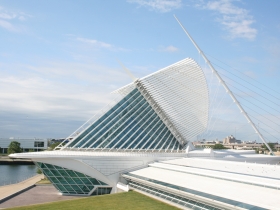The High Cost of Calatrava
Overruns on his projects are killing other cities. The impact on Milwaukee and its art museum was more positive.
Architect Santiago Calatrava, who greatly raised this city’s international profile with his addition to the Milwaukee Art Museum, has become the scourge of the world, it seems.
A recent New York Times story offers an often amusing account of how much he is now hated in the city of Valencia, Spain.
Calatrava is the architect there for a complex called the City of Arts and Sciences. It’s “the world’s largest collection of Mr. Calatrava’s work, which includes a performance hall, a bridge, a planetarium, an opera house, a science museum, a covered walkway and acres of reflecting pools,” the Times notes. Originally budgeted at about $405 million in U.S. dollars, its cost has nearly tripled. Ignacio Blanco, a member of the provincial parliament there, has created a Web site called Calatravatelaclava, which loosely translates, the story notes, as, “Calatrava bleeds you dry.”
“Calatrava was paid approximately 94 million euros (about $127 million) for his work,” the Times reports. “How could that be, Mr. Blanco asks, when the opera house included 150 seats with obstructed views? Or when the science museum was initially built without fire escapes or elevators for the disabled?”
Other problems include the smooth skin of the opera house which “began noticeably wrinkling just six years after the building opened” and the landscaped gardens beneath metal arches “that become so hot no vines will entwine them.”
“The roof of the performance hall leaks, they say. The opera was once flooded in a storm. Didn’t he know he was working in a riverbed?”
In Bilbao, Calatrava designed a footbridge with a glass tile surface that can be lighted from below. “But in a city that gets a lot of rain and occasional snow, pedestrians keep falling on the slippery surface. City officials say some 50 citizens have injured themselves, sometimes breaking legs or hips, on the bridge since it opened in 1997.” The Times dubbed this “The Bridge of Broken Legs.”
Milwaukee’s project suffered a similar fate. Its estimated cost rose from $38 million in 1997 to $122 million by the time it opened in 2001. Over the years I’ve heard that Milwaukee Art Museum board members have chastised themselves, feeling they failed in their oversight of the project.
I think that’s too harsh a judgment. For starters, as I concluded in a 2003 story for the Milwaukee Journal Sentinel, Milwaukee got a good deal from Calatrava. His fee was only $3 million, a pittance compared to the price he soon commanded world-wide. And the actual cost per square foot was $676 for the museum addition, while other American art museum and museum additions of the era ranged from $239 to $3,735 per square foot. Chris Smocke, who served as project manager for the Milwaukee project, told me it was “an absolute bargain.”
Yes, mistakes were made. Compared to Calatrava’s fee, the $6.7 million paid to David Kahler, the local architect on the project, seems questionable, all the more so when you consider that Kahler was a longtime art museum board member and thus friends with the decision-makers.
And in letting the cost of the project rise ever higher, the museum’s leaders left a big debt. Board member Sheldon Lubar led a successful effort to retire the $25 million debt a few years after the museum opened. Even so, the project’s overruns meant little money was available for an endowment to help operate and maintain the new building.
That has put a squeeze on the MAM’s expenses, requiring cuts in the curatorial staff and leaving the museum struggling to break even each year. Its annual federal tax forms show it had an annual deficit of $3.6 million in the 2011-2012 year and $4.6 million in the 2010-2011 year.
MAM Director Dan Keegan says the tax form “includes all sources of funds. So the deficit you are citing resulted from depreciation and endowment investment losses especially in 2008 and 2009.”
But those losses occurred two years earlier. For the years where these annual deficits occurred the museum reported investment gains of $3 million and $3.5 million, yet still showed a deficit.
Keegan stresses that the museum is debt-free but there’s little doubt the MAM has struggled financially since the Calatrava was built. Its budget was about $6.5 million before the addition was built, but jumped to about $15 or $16 million since, driven by the institution’s growth and added costs of maintenance and security.
Probably the biggest mistake by the museum’s leaders was in paying all this money just for an entrance hall to the MAM. The museum had long suffered from the fact that its entrance was at the back of the War Memorial, but the Calatrava addition represented an over-correction of grandiose proportions.
As critic Martin Filler put it in an analysis for the New York Review of Books, Calatrava’s “preference for bravura effect at the expense of function can also be discerned in the disparity between the Quadracci Pavilion’s extravagant superstructure, which is little more than a lobby, and the dreary exhibition galleries consigned to the concrete box beneath it like some bothersome afterthought.
New York Times critic Nicolai Ouroussoff gave the Calatrava a negative review for the same reason.
Yet, if the later reviews by more influential critics ending up panning Milwaukee’s Calatrava, by then it didn’t matter, because there had already been a flood of stories — nationally and internationally — gushing about Milwaukee’s new museum addition. And of course the addition has been a big hit with tourists. The project put Milwaukee on the world map in a new way, and was perhaps the first step in this city beginning to overcome its reputation as a dreary casualty of the Rust Belt.
If the Calatrava was both an asset and liability for the museum, it was all positive in its impact on the city, providing a new image for Milwaukee, one that Visit Milwaukee quickly adopted. In this city, at least, the name of Santiago Calatrava is still golden.
Murphy's Law
-
Is Legislature Biased Against Working Class?
 Apr 4th, 2024 by Bruce Murphy
Apr 4th, 2024 by Bruce Murphy
-
Associated Press Will Decline in Wisconsin
 Mar 27th, 2024 by Bruce Murphy
Mar 27th, 2024 by Bruce Murphy
-
City Attorney Race Is Vitally Important
 Mar 25th, 2024 by Bruce Murphy
Mar 25th, 2024 by Bruce Murphy


















Let’s do some math, according to your article……
Negative side.
Almost 100 million over budget, or more than three times the original cost estimate.
(What else could the Museum have done with 100 million dollars, better program and art maybe)
High maintenance costs
Loss of important staff members.
negative reviews from international architectural press.
Positive side
“Put Milwaukee on the world map in a new way “, whatever that means.
(The old one worked pretty well for a long time)
Provided image for city logo.
Positive reviews from local press and boosters.
Good location for car commercials, Hollywood action movies, and wedding photographs.
Big hit with people who come once to see the building, don’t care about art, and don’t contribute to the Museum.
Ah, the dramatic hood ornament adorning the Milwaukee lakefront. Providing such a lovely diversion to the wealthy near-shore high-rise dwellers. Imagine if, instead, the city’s well-heeled put the Calatrava project money to actually improving the city. Rehabbing some worn-out homes. Investing in a couple local business startups. Establishing some education scholarships. Now THAT would put Milwaukee on the map. But, no, the wealthy have their priorities, they need their distractions: watching the Calatrava fan open. Now let’s watch it close up. Watch as it gets hung up and needs more costly repairs.
Gallery space actually included in the grandiosity isn’t always a good thing. Look at what Renzo Piano gave us in Chicago–an Art Institute Modern Wing with fully integrated galleries…that looks almost exactly like a gigantic Apple Store on the inside. You walk inside and the first thing you do is wonder where the glass staircase is.
This building is an amazing success and one of the major contributing factors to several past and future development projects along the lake front. The taxes on the wealthy pay for a lot of shit, so why don’t you actually look at the big picture. Education scholarships and rehabbed homes are worthless drivers for the image of a city.
Oh come on guys. First of all, Spain is notorious for idiotic financial scandals so this says much more about Spain than Calatrava. Second, I don’t think very many readers of Urban Milwaukee lost any money in this deal. The Calatrava is fantastic. Enjoy it and put the critical energy somewhere useful!
@Tyrell I agree the Calatrava is fantastic.
I still get inspired every time I look at the museum (probably well over a thousand times at this point). My understanding is that the addition was paid for with private funds. Building the addition was not a choice between spending public money on some overpriced building or spending it on schools, business incentives, or some other social or economic need. Inspiration matters. Trying to occasionally to do great things matters.
Maybe when all of the fans of F.L Wright get through raising the funds to repair all of the poorly engineered grand projects he left behind, they could help out the people trying to rescue Calatrava’s buildings.
Calatrava has less of an excuse since he is a trained engineer as well as an architect.
I venture that worldwide more people know MIlwaukee is the home of this building than know if the Buck’s play in the Bradley Center or the Brewers play in Miller Park.
I think Milwaukee is lucky they have this building. Because Calatrava keep driving up the costs probably relates more to the strength of his personality than the board oversight.
Comparisons between Frank LLyod Wright and Santiago Calatrava are out of bounds. They are not in the league.
Also, anyone can like this building or that. But what about the fate of the entity inside the building? How would you feel if NW Mutuals new big tower bankrupted the company? No one expects it to make it a better company by the way.
Hi Bruce. Great piece. By pure coincidence, my family and I visited the City of Arts and Sciences this past Sunday. (We’ve relocated to Valencia, at least for the next year or so.) It’s breathtaking in its ambition, and — if you don’t look too closely — a stunningly beautiful and invigorating space to be in. (If I could post snapshots, I would.) Honestly, without knowing the unfortunate back story, you can’t help but feel something like wonder when you’re actually physically there.
But, as you note, it’s not wearing well. We’ve spent so much time outdoors in the parks surrounding the museums that we haven’t yet gotten inside. But the museums are rumored to suffer from some of the same problems ambitious stateside brick-and-mortar cultural projects have suffered — a grand shell with less-than-remarkable contents and programming that cost an arm and a leg to see. And it’s only part of a much bigger picture — everywhere in Spain, especially along the coasts, huge, luxurious residential and commercial construction projects have been abandoned practically in the middle of concrete being poured. The cranes have stood idle over them for years. As you note, by comparison, the Calatrava project in Milwaukee and the Madison project by Cesar Pelli are ringing successes.
I’m thinking, at ten years old, those wings probably will require some very expensive maintenance very soon.
I’d say that having the Calatrava on our lakefront is the equivalent of having a Ferrari parked in your driveway. (Or being able to take your Ferrari out for a spin!) Of course, maintenance on a Ferrari is quite a bit more than on a Toyota Camry or a Chevy Malibu, for instance the clutch on a Ferrari F1 transmission costs around $10k to replace and you’d be very lucky to get even 20k miles out of that clutch, but its Ferrari-its rolling automotive art! Apparently we have more than a few people here that would prefer driving their Camry or their Malibu. I’ll take the Ferrari in the driveway and the Calatrava on the lakefront, thank you!
I think there’s something wrong with Ferarris, and with Calatravas. Adolescent flash. We take away food stamps, and we fund football stadiums. Our priorities are fucked.
So what then, we should all be driving grey Camry’s and all of our buildings should be built “on the cheap” so we can give EVERYONE lots and lots of food stamps? Sounds quite a bit like the old USSR to me! Of course, as boring as a Camry is, it is a very well built car and all they could develop in the USSR was just junk, so maybe its a bit off in that regard.
It’s a real shame the MAM board and executive director at the time did not do a better job of projecting increased costs of operating an expanded facility, especially with unanticipated debt due to cost overruns. That is a legitimate responsibility of a nonprofit board. Other boards do it all the time. The Calatrava addition is beautiful and iconic.
I’m sure they did project for some cost overruns, probably the usual 10% or maybe 25% considering what a special project it was, but if I remember correctly, didn’t it end up being like FOUR TIMES the original budget???!!! I might be totally wrong on this, but if I remember correctly, wasn’t it originally supposed to cost something like $30 million and ended up costing over $100 million? Assuming that they had at least a half-competent accountant, they would’ve certainly had an account for “contingencies”, but when the entire project ends up being several times the entire original budget, well there’s no way of accounting for that!
OOPS! I guess the answer to my own question was in the above article! It was first budgeted at $38 mil and cost $122 mil in the end. How you’d account for that kind of overrun, I don’t know!
To clarify, I understand that there are always cost overruns for a project and that those can get out of hand, as they did here.
My concern, however, is that the board and executive director at the time seeming did not adequately anticipate the increased *operating* expenses associated with having a larger facility. These are much easier to anticipate and project than the all too frequent runaway cost overruns of a project, itself.
“Keegan stresses that the museum is debt-free but there’s little doubt the MAM has struggled financially since the Calatrava was built. Its budget was about $6.5 million before the addition was built, but jumped to about $15 or $16 million since, driven by the facility’s growth and added costs of maintenance and security.”
The article makes a lot of good points, as does pointing out the corruption in Spain may be an even bigger factor in what happens with many of Calatrava’s projects (obviously not the case in NY). However, how can we look back at the MAM’s project and not think it was absolutely worth every privately raised penny that was spent on it? As long as the MAM stays solvent, this has been one of the greatest projects Milwaukee has ever seen. It has helped usher in a new era for our city that will bring far more benefits then one can usually buy for $122 million. We can look back at how it could have been done differently, but to try and say we shouldn’t have done it at all or attempt to justify how even at it’s final cost it doesn’t have a far greater impact is ridiculous.
I will echo Judy and say that the City of Arts and Sciences in Valencia is breathtakingly beautiful, both inside and out. You can google it to see pictures. My wife and I were also able to see Puente de la Mujer (Bridge of the Woman) by Calatrava in Buenos Aires. Also very beautiful. When you have 2 children who studied abroad to learn Spanish, you have to check on how they are doing. I also recall reading about how rewarding the work on the Art Museum here was for the workers who constructed it.
What I don’t understand, and I hope another reader does, is why can’t there be some provision in the original contract that stipulates something like, If the final cost is higher than the original estimate, then the architect has to shoulder some measure or percentage of that overrun?
Bill, why would the architect have to shoulder the additional cost? My guess is that his price for the design didn’t change that much, it was the construction costs. What artist would agree to be ruined financially for working for a city that penalizes them for circumstances out of their expertise or control? Do you try to bill Ikea for your time when it takes you longer to assemble a shelf than their instructions indicate it should?
Kyle, I honestly don’t know how the process works so I would welcome information from anyone who does. My impression was that the architect submits an overall plan or estimate in competition with other architects. Part of this estimate is some evaluation for the cost of materials, labor, etc. There has to be some rhyme and reason to the process so someone can’t just lowball an estimate to get the contract and then have no responsibility when things end up costing 2 or 3 times as much as the original estimate. I recognize that whoever signs the contract with the architect bears considerable responsibility, but it also seems that there should be some provision included in the contract that is an incentive for the architectural team to control costs.
A very, very minor example of this that I had some painting done on my house. I had gotten several estimates. The company that did the work did a first rate job, but the cost was adding up to almost twice the estimate. The owner of the company agreed to absorb part of the extra cost.
It would take me longer to assemble a shelf from Ikea than it took them to build the entire City of Arts and Sciences.
The only problem with your theory of getting “estimates” from various architects and comparing it to getting estimates for painting your house is that your talking about Calatrava here, one of the most if not the most sought after architect in the world here. Its not like you’d get his estimate and then compare it with estimates from a few others in town!